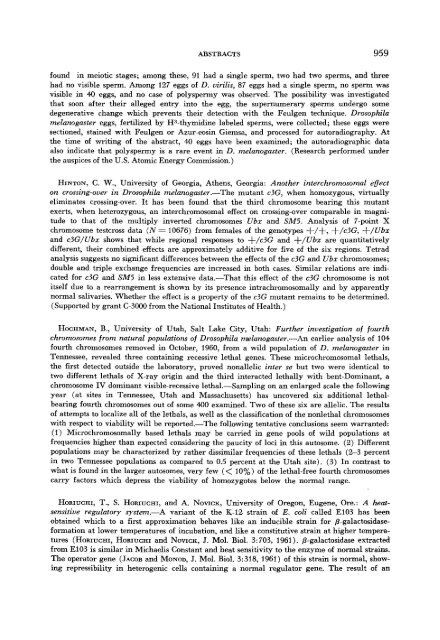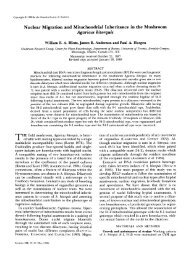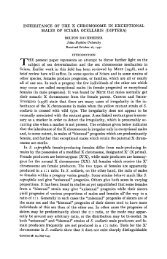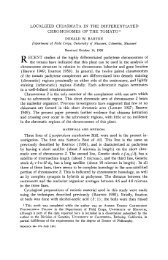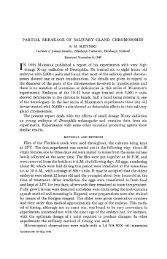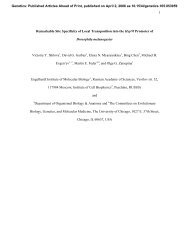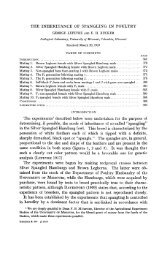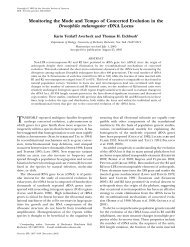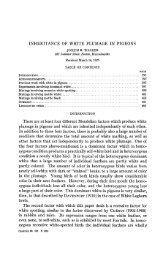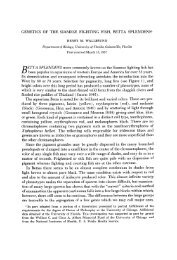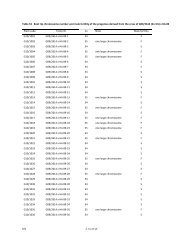abstracts of papers presented at the 1962 meetings - Genetics
abstracts of papers presented at the 1962 meetings - Genetics
abstracts of papers presented at the 1962 meetings - Genetics
You also want an ePaper? Increase the reach of your titles
YUMPU automatically turns print PDFs into web optimized ePapers that Google loves.
ABSTRACTS 959<br />
found in meiotic stages; among <strong>the</strong>se, 91 had a single sperm, two had two sperms, and three<br />
had no visible sperm. Among 127 eggs <strong>of</strong> D. virilis, 87 eggs had a single sperm, no sperm was<br />
visible in 40 eggs, and no case <strong>of</strong> polyspermy was observed. The possibility was investig<strong>at</strong>ed<br />
th<strong>at</strong> soon after <strong>the</strong>ir alleged entry into <strong>the</strong> egg, <strong>the</strong> supernumerary sperms undergo some<br />
degener<strong>at</strong>ive change which prevents <strong>the</strong>ir detection with <strong>the</strong> Feulgen technique. Drosophila<br />
melanogaster eggs, fertilized by H3-thymidine labeled sperms, were collected; <strong>the</strong>se eggs were<br />
sectioned, stained with Feulgen or Azur-eosin Giemsa, and processed for autoradiography. At<br />
<strong>the</strong> time <strong>of</strong> writing <strong>of</strong> <strong>the</strong> abstract, 40 eggs have been examined; <strong>the</strong> autoradiographic d<strong>at</strong>a<br />
also indic<strong>at</strong>e th<strong>at</strong> polyspermy is a rare event in D. melanogaster. (Research performed under<br />
<strong>the</strong> auspices <strong>of</strong> <strong>the</strong> U.S. Atomic Energy Commission.)<br />
HINTON, C. W., University <strong>of</strong> Georgia, A<strong>the</strong>ns, Georgia: Ano<strong>the</strong>r interchromosomal effect<br />
on crossing-over in Drosophila meLanogaster.-The mutant c3G, when homozygous, virtually<br />
elimin<strong>at</strong>es crossing-over. It has been found th<strong>at</strong> <strong>the</strong> third chromosome bearing this mutant<br />
exerts, when heterozygous, an interchromosomal effect on crossing-over comparable in magni-<br />
tude to th<strong>at</strong> <strong>of</strong> <strong>the</strong> multiply inverted chromosomes Ubx and SM5. Analysis <strong>of</strong> T-point X<br />
chromosome testcross d<strong>at</strong>a (N = 10676) from females <strong>of</strong> <strong>the</strong> genotypes +/+, +/c3G, +/Ubx<br />
and c3G/Ubx shows th<strong>at</strong> while regional responses to +/c3G and +/Ubx are quantit<strong>at</strong>ively<br />
different, <strong>the</strong>ir combined effects are approxim<strong>at</strong>ely additive for five <strong>of</strong> <strong>the</strong> six regions. Tetrad<br />
analysis suggests no significant differences between <strong>the</strong> effects <strong>of</strong> <strong>the</strong> c3G and Ubx chromosomes;<br />
double and triple exchange frequencies are increased in both cases. Similar rel<strong>at</strong>ions are indi-<br />
c<strong>at</strong>ed for c3G and SM5 in less extensive d<strong>at</strong>a.-Th<strong>at</strong> this effect <strong>of</strong> <strong>the</strong> c3G chromosome is not<br />
itself due to a rearrangement is shown by its presence intrachromosomally and by apparently<br />
normal salivaries. Whe<strong>the</strong>r <strong>the</strong> effect is a property <strong>of</strong> <strong>the</strong> c3G mutant remains to be determined.<br />
(Supported by grant C-3000 from <strong>the</strong> N<strong>at</strong>ional Institutes <strong>of</strong> Health.)<br />
HOCHMAN, B., University <strong>of</strong> Utah, Salt Lake City, Utah: Fur<strong>the</strong>r investig<strong>at</strong>ion <strong>of</strong> fourth<br />
chromosomes from n<strong>at</strong>ural popul<strong>at</strong>ions <strong>of</strong> Drosophila m1anogaster.-An earlier analysis <strong>of</strong> 104<br />
fourth chromosomes removed in October, 1960, from a wild popul<strong>at</strong>ion <strong>of</strong> D. melanogaster in<br />
Tennessee, revealed three containing recessive lethal genes. These microchromosomal lethals,<br />
<strong>the</strong> first detected outside <strong>the</strong> labor<strong>at</strong>ory, proved nonallelic inter se but two were identical to<br />
two different lethals <strong>of</strong> X-ray origin and <strong>the</strong> third interacted lethally with bent-Dominant, a<br />
chromosome IV dominant visible-recessive lethal.-Sampling on an enlarged scale <strong>the</strong> following<br />
year (<strong>at</strong> sites in Tennessee, Utah and Massachusetts) has uncovered six additional lethalbearing<br />
fourth chromosomes out <strong>of</strong> some MO examined. Two <strong>of</strong> <strong>the</strong>se six are allelic. The results<br />
<strong>of</strong> <strong>at</strong>tempts to localize all <strong>of</strong> <strong>the</strong> lethals, as well as <strong>the</strong> classific<strong>at</strong>ion <strong>of</strong> <strong>the</strong> nonlethal chromosomes<br />
with respect to viability will be reported.-The following tent<strong>at</strong>ive conclusions seem warranted:<br />
(1) Microchromosomally based lethals may be carried in gene pools <strong>of</strong> wild popul<strong>at</strong>ions <strong>at</strong><br />
frequencies higher than expected considering <strong>the</strong> paucity <strong>of</strong> loci in this autosome. (2) Different<br />
popul<strong>at</strong>ions may be characterized by r<strong>at</strong>her dissimilar frequencies <strong>of</strong> <strong>the</strong>se lethals (2-3 percent<br />
in two Tennessee popul<strong>at</strong>ions as compared to 0.5 percent <strong>at</strong> <strong>the</strong> Utah site). (3) In contrast to<br />
wh<strong>at</strong> is found in <strong>the</strong> larger autosomes, very few (< 10%) <strong>of</strong> <strong>the</strong> lethal-free fourth chromosomes<br />
carry factors which depress <strong>the</strong> viability <strong>of</strong> homozygotes below <strong>the</strong> normal range.<br />
HORIUCHI, T., S. HORIUCHI, and A. NOMCK, University <strong>of</strong> Oregon, Eugene, Ore.: A he<strong>at</strong>sensitive<br />
regul<strong>at</strong>ory system.-A variant <strong>of</strong> <strong>the</strong> K-12 strain <strong>of</strong> E. coli called E103 has been<br />
obtained which to a first approxim<strong>at</strong>ion behaves like an inducible strain for P-galactosidaseform<strong>at</strong>ion<br />
<strong>at</strong> lower temper<strong>at</strong>ures <strong>of</strong> incub<strong>at</strong>ion, and like a constitutive strain <strong>at</strong> higher temper<strong>at</strong>ures<br />
(HORIUCHI, HORIUCHI and NOVICK, J. Mol. Biol. 3: 703, 1961). p-galactosidase extracted<br />
from E103 is similar in Michaelis Constant and he<strong>at</strong> sensitivity to <strong>the</strong> enzyme <strong>of</strong> normal strains.<br />
The oper<strong>at</strong>or gene (JACOB and MONOD, J. Mol. Biol. 3:318, 1961) <strong>of</strong> this strain is normal, showing<br />
repressibility in heterogenic cells containing a normal regul<strong>at</strong>or gene. The result <strong>of</strong> an


